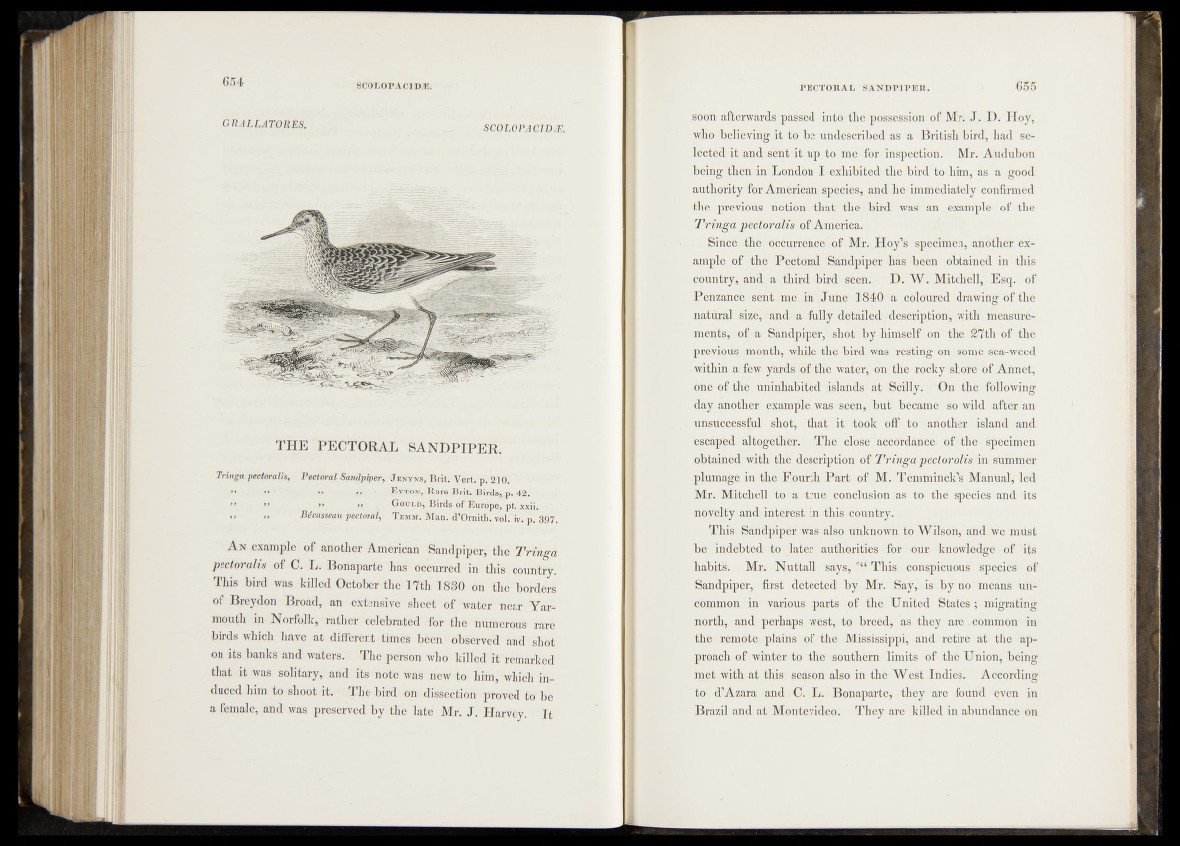
GRALLATORES. SCOLOPACTDJE.
T H E PECTORAL SA N D P IPE R .
Tringa pectoral!s, Pectoral Sandpiper, J enyns, Brit. Vert, p. 210.
»* n ' » r> E yton, Rare Brit. Bird&p. 42.
” „ , »»• » ... Gould, Birds ofEurope, pt. xxii, j
»» » Bicasseau pectoral, Temm. Man. d’Ornith.voT.iv. p. 397,
An example of another American Sandpiper, the Tringa
pectoralis of C. L. Bonaparte has occurred in this country.
This bird was killed October the 17th 1880 on the borders
of Breydon Broad, an extensive sheet of water near Yarmouth
in Norfolk, rather celebrated for the numerous rare
birds which have at different times been observed and shot
on its banks and waters. The person who killed it remarked
that it was solitary, and its note was new to him, which induced
him to shoot it. The bird on dissection proved to be
a female, and was preserved by the late Mr. J. Harvey. It
soon afterwards passed into the possession of Mr. J . D. Hoy,
who believing it to be undescribed as a British bird, had selected
it and sént it up to tne for inspection. Mr. Audubon
being then in London I exhibited the bird to him, as a good
authority for American species, and he immediately confirmed
the previous notion that the bird was an example of the
Tringa pectoralis of America.
Since the occurrence of Mr. Hoy’s specimen, another example
of the Pectoral Sandpiper has been obtained in this
country, and a third bird seen.- D. W. Mitchell, Esq. of
Penzance sent me in June 1810 a coloured drawing of thé
natural size, and a fully detailed, description, with measurements,
of' a Sandpiper, shot by himself on the 27 th of the
previous month, while the bird was resting on some sea-weed
within a few yards of the water, on the rocky shore of Annet,
one of the uninhabited islands at Scilly.. On the following
day another example .was seen, but became so wild after an
unsuccessful shot, that it took off to another island and
escapèd altogether. The close accordance of the specimen
obtained with the description of Tringa pectoralis in- summer
plumage in the Fourth Part of M. Temminck’s Manual, led
Mr. Mitchell to a true conclusion as to the species and its
novelty and interest in this country.
This Sandpiper was also unknown to Wilson, and we must
be indebted to later authorities for our knowledge of its
habits. Mr. Nuttall says, *“ This conspicuous species of
Sandpiper, first detected by Mr. Say, .is by no means uncommon
in various parts of the United States ; migrating
north, and perhaps west, to breed, as they are .common in
the remote plains of the Mississippi, and retire at the -approach
of winter to the southern limits of the Union, being
met with at this season also in the West Indies. According
to d’Azara and C. L. Bonaparte, they are found even in
Brazil and at Montevideo. They are killed in abundance on